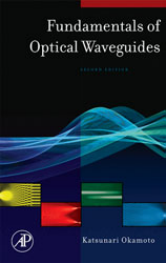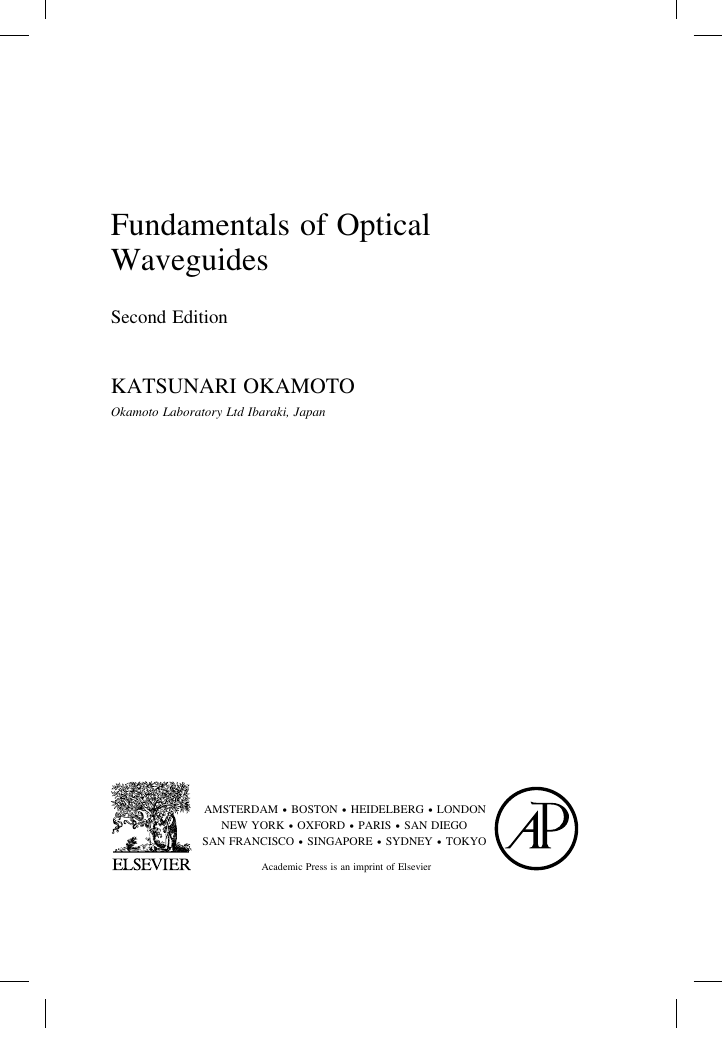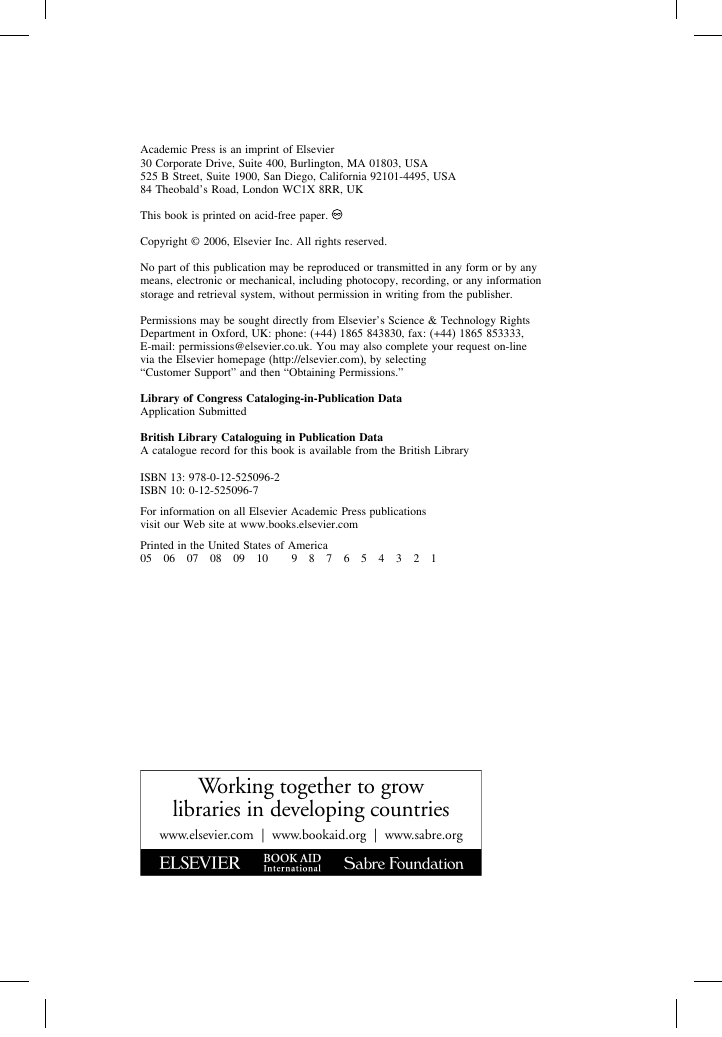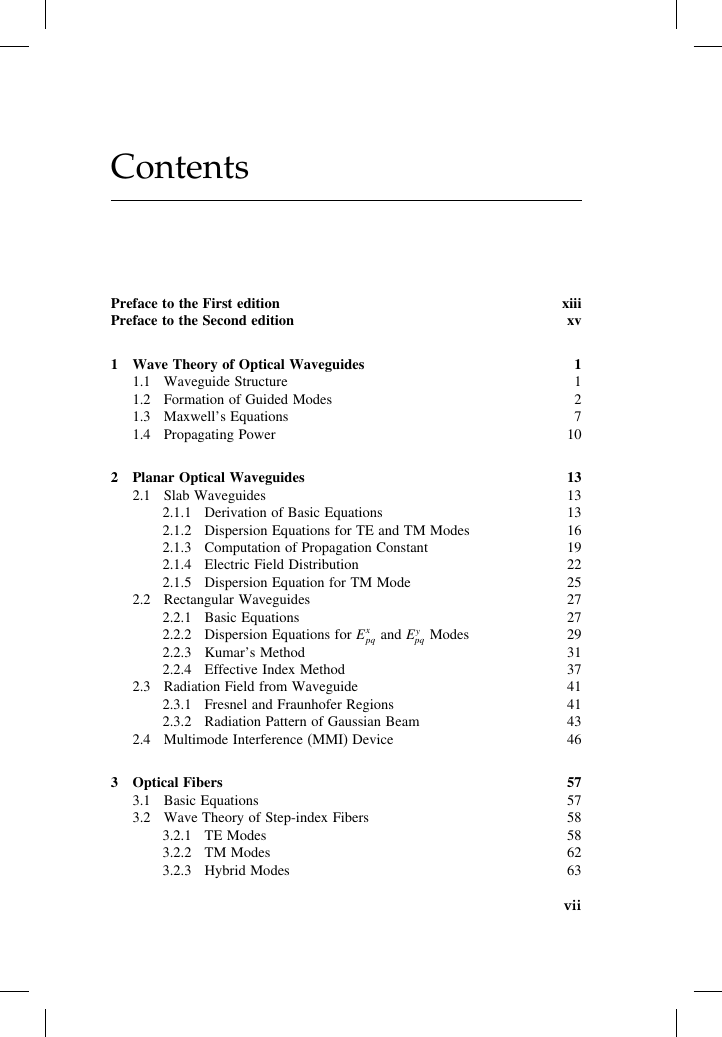front cover
copyright
table of contents
front matter
Preface to the First Edition
Preface to the Second Edition
body
1 Wave Theory of Optical Waveguides
1.1. WAVEGUIDE STRUCTURE
1.2. FORMATION OF GUIDED MODES
1.3. MAXWELL’S EQUATIONS
1.4. PROPAGATING POWER
Chapter 1 REFERENCES
2 Planar Optical Waveguides
2.1. SLAB WAVEGUIDES
2.1.1. Derivation of Basic Equations
2.1.2. Dispersion Equations for TE and TM Modes
2.1.3. Computation of Propagation Constant
2.1.4. Electric Field Distribution
2.1.5. Dispersion Equation for TM Mode
2.2. RECTANGULAR WAVEGUIDES
2.2.1. Basic Equations
2.2.2. Dispersion Equations for Expq and Eypq Modes
2.2.3. Kumar’s Method
2.2.4. Effective Index Method
2.3. RADIATION FIELD FROM WAVEGUIDE
2.3.1. Fresnel and Fraunhofer Regions
2.3.2. Radiation Pattern of Gaussian Beam
2.4. MULTIMODE INTERFERENCE (MMI) DEVICE
Chapter 2 REFERENCES
3 Optical Fibers
3.1. BASIC EQUATIONS
3.2. WAVE THEORY OF STEP-INDEX FIBERS
3.2.1. TE Modes
3.2.2. TM Modes
3.2.3. Hybrid Modes
3.3. OPTICAL POWER CARRIED BY EACH MODE
3.3.1. TE Modes
3.3.2. TM Modes
3.3.3. Hybrid Modes
3.4. LINEARLY POLARIZED (LP) MODES
3.4.1. Unified Dispersion Equation for LP Modes
3.4.2. Dispersion Characteristics of LP Modes
3.4.3. Propagating Power of LP Modes
3.5. FUNDAMENTAL HE11 MODE
3.6. DISPERSION CHARACTERISTICS OF STEP-INDEX FIBERS
3.6.1. Signal Distortion Caused by Group Velocity Dispersion
3.6.2. Mechanisms Causing Dispersion
3.6.3. Derivation of Delay-time Formula
3.6.4. Chromatic Dispersion
3.6.5. Zero-dispersion Wavelength
3.7. WAVE THEORY OF GRADED-INDEX FIBERS
3.7.1. Basic Equations and Mode Concepts in Graded- index Fibers
3.7.2. Analysis of Graded-index Fibers by the WKB Method
3.7.3. Dispersion Characteristics of Graded-index Fibers
3.8. RELATION BETWEEN DISPERSION AND TRANSMISSION CAPACITY
3.8.1. Multimode Fiber
3.8.2. Single-mode Fiber
3.9. BIREFRINGENT OPTICAL FIBERS
3.9.1. Two Orthogonally-polarized Modes in Nominally Single-mode Fibers
3.9.2. Derivation of Basic Equations
3.9.3. Elliptical-core Fibers
3.9.4. Modal Birefringence
3.9.5. Polarization Mode Dispersion
3.10. DISPERSION CONTROL IN SINGLE-MODE OPTICAL FIBERS
3.10.1. Dispersion Compensating Fibers
3.10.2. Dispersion-shifted Fibers
3.10.3. Dispersion Flattened Fibers
3.10.4. Broadly Dispersion Compensating Fibers
3.11. PHOTONIC CRYSTAL FIBERS
Appendix 3A Vector wave equations in graded-index fibers
Appendix 3B Derivation of equation (3.219)
Chapter 3 REFERENCES
4 Coupled Mode Theory
4.1. DERIVATION OF COUPLED MODE EQUATIONS BASED ON PERTURBATION THEORY
4.2. CODIRECTIONAL COUPLERS
4.3. CONTRADIRECTIONAL COUPLING IN CORRUGATED WAVEGUIDES
4.3.1. Transmission and Reflection Characteristics in Uniform Gratings
4.3.2. Phase-shift Grating
4.4. DERIVATION OF COUPLING COEFFICIENTS
4.4.1. Coupling Coefficients for Slab Waveguides
4.4.2. Coupling Coefficients for Rectangular Waveguides
4.4.3. Derivation of Coupling Coefficients Based on Mode Interference
4.4.4. Coupling Coefficients for Optical Fibers
4.4.5. Coupling Coefficients for Corrugated Waveguides
4.5. OPTICAL WAVEGUIDE DEVICES USING DIRECTIONAL COUPLERS
4.5.1. Mach–Zehnder Interferometers
4.5.2. Ring Resonators
4.5.3. Bistable Devices
4.6. FIBER BRAGG GRATINGS
Appendix 4A Derivation of Equations (4.8) and (4.9)
Appendix 4B Exact Solutions for the Coupled Mode Equations ( 4.26) and ( 4.27)
Chapter 4 REFERENCES
5 Nonlinear Optical Effects in Optical Fibers
5.1. FIGURE OF MERIT FOR NONLINEAR EFFECTS
5.2. OPTICAL KERR EFFECT
5.2.1. Self-phase Modulation
5.2.2. Nonlinear Schrödinger Equation
5.3. OPTICAL SOLITONS
5.3.1. Fundamental and Higher-Order Solitons
5.3.2. Fiber Loss Compensation by Optical Amplification
5.3.3. Modulational Instability
5.3.4. Dark Solitons
5.4. OPTICAL PULSE COMPRESSION
5.5. LIGHT SCATTERING IN ISOTROPIC MEDIA
5.5.1. Vibration of One-Dimensional Lattice
5.5.2. Selection Rules for Light Scattering by Phonons
5.6. STIMULATED RAMAN SCATTERING
5.7. STIMULATED BRILLOUIN SCATTERING
5.8. SECOND-HARMONIC GENERATION
5.9. ERBIUM-DOPED FIBER AMPLIFIER
5.10. FOUR-WAVE MIXING IN OPTICAL FIBER
Chapter 5 REFERENCES
6 Finite Element Method
6.1. INTRODUCTION
6.2. FINITE ELEMENT METHOD ANALYSIS OF SLAB WAVEGUIDES
6.2.1. Variational Formulation
6.2.2. Discretization of the Functional
6.2.3. Dispersion Equation Based on the Stationary Condition
6.2.4. Dispersion Characteristics of Graded-index Slab Waveguides
6.3. FINITE ELEMENT METHOD ANALYSIS OF OPTICAL FIBERS
6.3.1. Variational Formulation
6.3.2. Discretization of the Functional
6.3.3. Dispersion Equation Based on the Stationary Condition
6.3.4. Single-mode Conditions of Graded-index Fibers
6.3.5. Variational Expression for the Delay Time
6.4. FINITE ELEMENT METHOD ANALYSIS OF RECTANGULAR WAVEGUIDES
6.4.1. Vector and Scalar Analyses
6.4.2. Variational Formulation and Discretization into Finite Number of Elements
6.4.3. Dispersion Equation Based on the Stationary Condition
6.5. STRESS ANALYSIS OF OPTICAL WAVEGUIDES
6.5.1. Energy Principle
6.5.2. Plane Strain and Plane Stress
6.5.3. Basic Equations for Displacement, Strain and Stress
6.5.4. Formulation of the Total Potential Energy
6.5.5. Solution of the Problem by the Stationary Condition
6.5.6. Combination of Finite-Element Waveguide and Stress Analysis
6.6. SEMI-VECTOR FEM ANALYSIS OF HIGH-INDEX CONTRAST WAVEGUIDES
6.6.1. E-field Formulation
6.6.2. H-field Formulation
6.6.3. Steady State Mode Analysis
6A Derivation of Equation (6.59)
6B Proof of Equation (6.66)
Chapter 6 REFERENCES
7 Beam Propagation Method
7.1. BASIC EQUATIONS FOR BEAM PROPAGATION METHOD BASED ON THE FFT
7.1.1. Wave Propagation in Optical Waveguides
7.1.2. Pulse Propagation in Optical Fibers
7.2. FFTBPM ANALYSIS OF OPTICAL WAVE PROPAGATION
7.2.1. Formal Solution Using Operators
7.2.2. Concrete Numerical Procedures Using Split-step Fourier Algorithm
7.3. FFTBPM ANALYSIS OF OPTICAL PULSE PROPAGATION
7.4. DISCRETE FOURIER TRANSFORM
7.5. FAST FOURIER TRANSFORM
7.6. FORMULATION OF NUMERICAL PROCEDURES USING DISCRETE FOURIER TRANSFORM
7.7. APPLICATIONS OF FFTBPM
7.8. FINITE DIFFERENCE METHOD ANALYSIS OF PLANAR OPTICAL WAVEGUIDES
7.8.1. Derivation of Basic Equations
7.8.2. Transparent Boundary Conditions
7.8.3. Solution of Tri-diagonal Equations
7.9. FDMBPM ANALYSIS OF RECTANGULAR WAVEGUIDES
7.10. FDMBPM ANALYSIS OF OPTICAL PULSE PROPAGATION
7.11. SEMI-VECTOR FDMBPM ANALYSIS OF HIGH- INDEX CONTRAST WAVEGUIDES
7.11.1. Quasi-TE Modes
7.11.2. Quasi-TM Modes
7.11.3. Polarization Splitter Using Silicon-on-Insulator (SOI) Waveguide
7.12. FINITE DIFFERENCE TIME DOMAIN (FDTD) METHOD
Chapter 7 REFERENCES
8 Staircase Concatenation Method
8.1. STAIRCASE APPROXIMATION OF WAVEGUIDE BOUNDARY
8.2. AMPLITUDES AND PHASES BETWEEN THE CONNECTING INTERFACES
8.3. WAVELENGTH DIVISION MULTIPLEXING COUPLERS
8.4. WAVELENGTH-FLATTENED COUPLERS
Chapter 8 REFERENCES
9 Planar Lightwave Circuits
9.1. WAVEGUIDE FABRICATION
9.2. N×N STAR COUPLER
9.3. ARRAYED-WAVEGUIDE GRATING
9.3.1. Principle of Operation and Fundamental Characteristics
9.3.2. Analytical Treatment of AWG Demultiplexing Properties
9.3.3. Waveguide Layout of AWG
9.3.4. Gaussian Spectral Response AWG
9.3.5. Polarization Dependence of Pass Wavelength
9.3.6. Vernier Technique for the Center Wavelength Adjustment
9.4. CROSSTALK AND DISPERSION CHARACTERISTICS OF AWGs
9.4.1. Crosstalk of AWGs
9.4.2. Dispersion Characteristics of AWGs
9.5. FUNCTIONAL AWGs
9.5.1. Flat Spectral Response AWG
9.5.2. Loss Reduction in AWG
9.5.3. Unequal Channel Spacing AWG
9.5.4. Variable Bandwidth AWG
9.5.5. Uniform-loss and Cyclic-frequency (ULCF) AWG
9.5.6. Athermal (Temperature Insensitive) AWG
9.5.7. Multiwavelength Simultaneous Monitoring Device Using AWG
9.5.8. Phase Error Compensation of AWG
9.5.9. Tandem AWG Configuration
9.6. RECONFIGURABLE OPTICAL ADD/DROP MULTIPLEXER (ROADM)
9.7. N×N MATRIX SWITCHES
9.8. LATTICE-FORM PROGRAMMABLE DISPERSION EQUALIZERS
9.9. TEMPORAL PULSE WAVEFORM SHAPERS
9.10. COHERENT OPTICAL TRANSVERSAL FILTERS
9.11. OPTICAL LABEL RECOGNITION CIRCUIT FOR PHOTONIC LABEL SWITCH ROUTER
9.12. POLARIZATION MODE DISPERSION COMPENSATOR
9.13. HYBRID INTEGRATION TECHNOLOGY USING PLC PLATFORMS
Chapter 9 REFERENCES
10 Several Important Theorems and Formulas
10.1. GAUSS’S THEOREM
10.2. GREEN’S THEOREM
10.3. STOKES’ THEOREM
10.4. INTEGRAL THEOREM OF HELMHOLTZ AND KIRCHHOFF
10.5. FRESNEL–KIRCHHOFF DIFFRACTION FORMULA
10.6. FORMULAS FOR VECTOR ANALYSIS
10.7. FORMULAS IN CYLINDRICAL AND SPHERICAL COORDINATES
10.7.1. Cylindrical Coordinates
10.7.2. Spherical Coordinates
Chapter 10 REFERENCES
Index
















 2023年江西萍乡中考道德与法治真题及答案.doc
2023年江西萍乡中考道德与法治真题及答案.doc 2012年重庆南川中考生物真题及答案.doc
2012年重庆南川中考生物真题及答案.doc 2013年江西师范大学地理学综合及文艺理论基础考研真题.doc
2013年江西师范大学地理学综合及文艺理论基础考研真题.doc 2020年四川甘孜小升初语文真题及答案I卷.doc
2020年四川甘孜小升初语文真题及答案I卷.doc 2020年注册岩土工程师专业基础考试真题及答案.doc
2020年注册岩土工程师专业基础考试真题及答案.doc 2023-2024学年福建省厦门市九年级上学期数学月考试题及答案.doc
2023-2024学年福建省厦门市九年级上学期数学月考试题及答案.doc 2021-2022学年辽宁省沈阳市大东区九年级上学期语文期末试题及答案.doc
2021-2022学年辽宁省沈阳市大东区九年级上学期语文期末试题及答案.doc 2022-2023学年北京东城区初三第一学期物理期末试卷及答案.doc
2022-2023学年北京东城区初三第一学期物理期末试卷及答案.doc 2018上半年江西教师资格初中地理学科知识与教学能力真题及答案.doc
2018上半年江西教师资格初中地理学科知识与教学能力真题及答案.doc 2012年河北国家公务员申论考试真题及答案-省级.doc
2012年河北国家公务员申论考试真题及答案-省级.doc 2020-2021学年江苏省扬州市江都区邵樊片九年级上学期数学第一次质量检测试题及答案.doc
2020-2021学年江苏省扬州市江都区邵樊片九年级上学期数学第一次质量检测试题及答案.doc 2022下半年黑龙江教师资格证中学综合素质真题及答案.doc
2022下半年黑龙江教师资格证中学综合素质真题及答案.doc